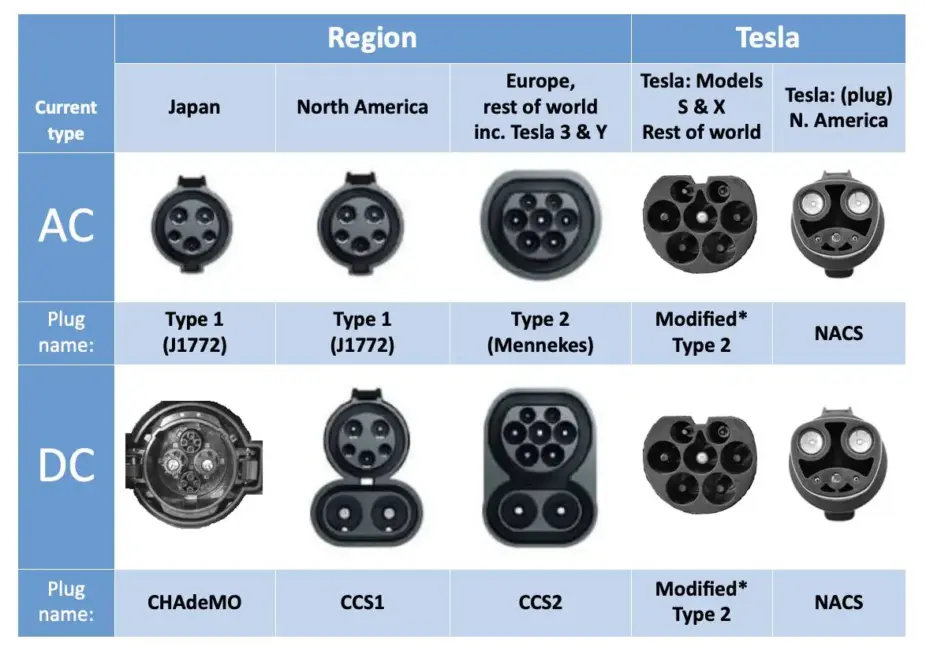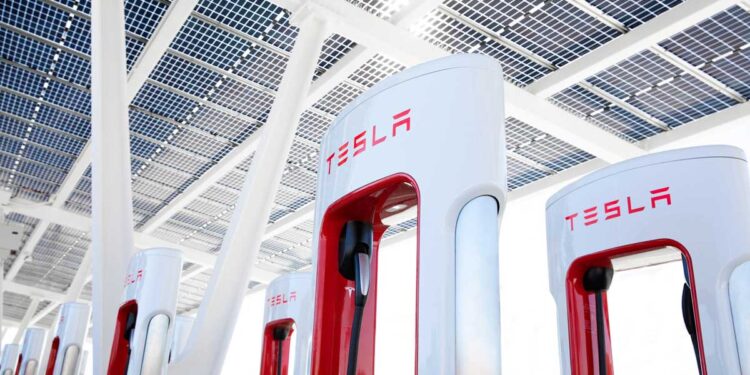Is Tesla US to become the last to lose the Plug War?
An interesting side-battle of the Plug War has been the unique Tesla standard plug in the US. Originally introduced for the Model S back in 2012 (before the now dominant CCS system was rolled out) – it has long been the odd-man-out when it comes to plug standards and remains largely restricted to the North American market.
Elsewhere1, Tesla uses the same AC socket as everyone else – and for the Models 3 and Y, the same AC and DC socket2.
Even for the Models S and X, Tesla in late 2019/20 added the capacity for them to use an adaptor to access CCS2 DC chargers3. Along with the socket changes being made by other EV manufacturers around this time, it effectively heralded the end of the Plug War.
As I wrote back in 2018, the fact that Tesla uses different sockets had also been something of a historical accident – it is likely they would have used an open standard had it existed at the time. It seems however Tesla are now ‘doubling down’ on their US standard rather than moving to CCS – of which, incidentally, they are a development partner.

* Note notches at top and at centre pin of Tesla modified Type 2 socket. Tesla Supercharger (DC) plugs have matching ‘keys’ to prevent insertion into non-tesla charge sockets.
I say this because Tesla has recently renamed its proprietary standard the ‘North American Charging Standard’ (NACS) and made it available to all manufacturers to use instead of the CCS AC/DC combo socket or the (now dying) CHAdeMO DC standard.
Aptera (who have yet to sell an EV) quickly announced it would adopt NACS – but the other manufacturers have rejected it. In fact, as a group (through CharIN – the industry body that manages the CCS standard and of which they – and Tesla – are members) they have now written in response to Tesla’s NACS announcement.
“We strongly encourage Tesla, as a CharIN member, to work with CharIN’s membership base, the standards organizations, and others to accelerate the adoption of a fully interoperable EV charging solution to transition to electric vehicles more quickly,” the letter says.
CharIN also make the point that: “we encourage stakeholders to investigate ways to focus on market acceleration rather than the creation of yet another form factor alternative, which will lead to further consumer confusion and delay EV adoption.”
Especially so, as CharIN further wrote, NACS would have a long and uncertain path to becoming a true international standard.
“CharIN supports a rigorous peer review process applied to the development of standards, such as ISO, IEC, and SAE. The current CCS standard, including connectors and related communications protocols, is a true international standard that has gone through the standardization process described above,” the letter continues.
“Any newly introduced idea, including a mechanical improvement to the existing CCS connector design, would have to follow the same process before the industry can safely adopt it. There is a significant chance that what is ultimately approved in the standards development process may not align with what is currently proposed by Tesla.”
As to why Tesla is trying to reignite the Plug War, there are two possible reasons I can think of: One is that with recent US federal funding becoming available to open charging networks, Tesla may be attempting to rebrand their closed proprietary network as open to garner government funding.
The second is that North American CCS DC charger numbers are increasing fast – and according to Plugshare, recently surpassed the number of Tesla Superchargers there.
US federal funding of the now victorious rival in the Plug War between CCS and CHAdeMO puts Tesla in the awkward long-term position of ultimately having a smaller, closed network with all the other manufacturers finally having access to a larger, well placed CCS network.
Given Tesla has long touted its extensive North American charging network as a key reason to buy a Tesla, this would be a major blow for Tesla prestige … and even perhaps sales in the longer term.
However, the wrap of Tesla’s manoeuvres for markets outside of North America is that it is a battle of no consequence. NACS will never be adopted for 3 phase power supply markets (like Australia, New Zealand, Europe and most of the rest of the world).
Any vehicle manufacturer outside of the North American market will simply have to offer the CCS socket as no NACS chargers would exist – even Tesla could not change from CCS where it currently uses it as Tesla does not install NACS Supercharger plugs (or sell cars that use it) in those countries.
All up, trying to get NACS adopted in North America (or anywhere else were it to try) simply sows confusion in the marketplace and works against Tesla’s stated aim to accelerate the adoption of electric transport.
As a final note, Tesla’s move to reopen a skirmish in the Plug War almost reminds me of the last WWII Japanese soldier to surrender in 1974. He simply didn’t know the war was already over …
* Notes:
- Outside of North America, the NACS plug is used in South Korea and Japan only.
- For the more technically minded: when Tesla started exporting the Model S to markets outside North America/South Korea/Japan, Tesla adopted a modified Type 2 AC socket to include DC charging within it – which remains in use for the Tesla Models S and X. With the introduction of the Model 3 (and later the Model Y) to other markets, Tesla adopted the full CCS2 socket.
- These are not available to Australian Models S and X as no new Models S or X have been sold in Australia since early 2020.

Bryce Gaton is an expert on electric vehicles and contributor for The Driven and Renew Economy. He has been working in the EV sector since 2008 and is currently working as EV electrical safety trainer/supervisor for the University of Melbourne. He also provides support for the EV Transition to business, government and the public through his EV Transition consultancy EVchoice.




